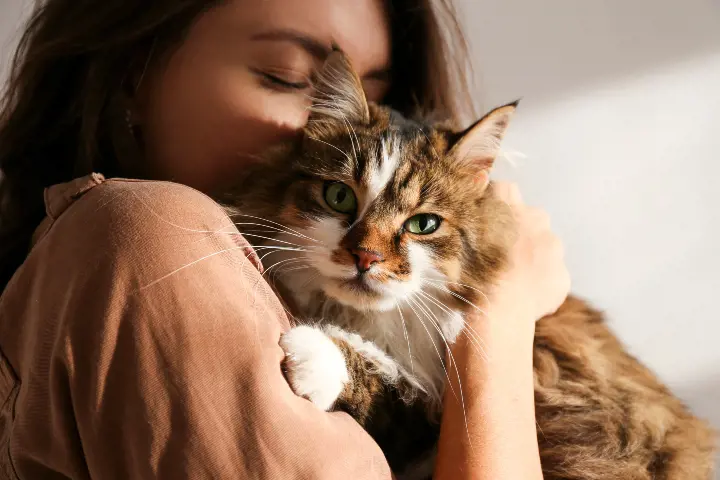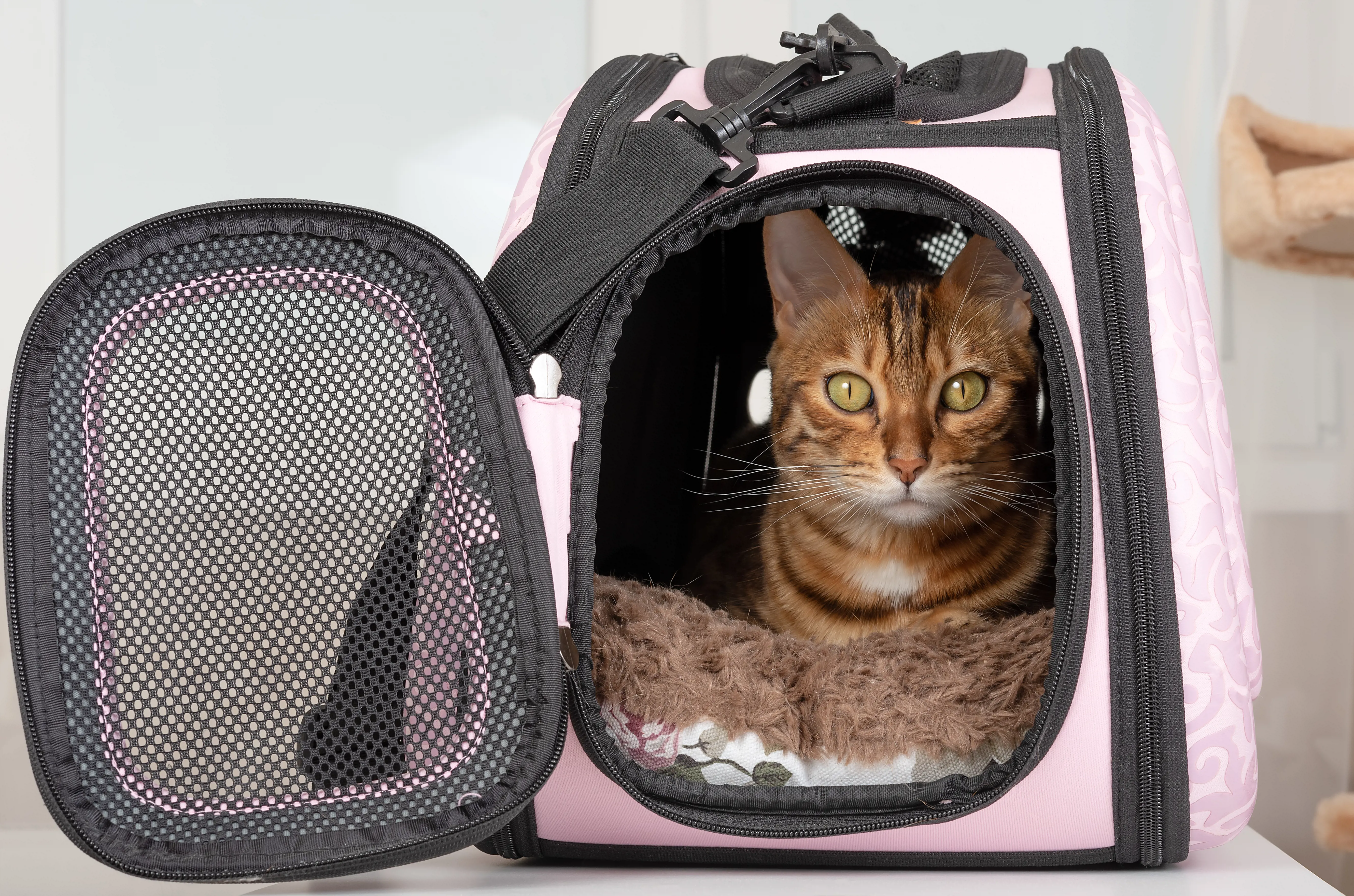How to correctly pet your cat
19th July, 2023

Is your cat not keen on cuddles? Do they avoid your lap at all costs? Maybe you’re not petting them correctly! Here’s how to do it the right way…
Is there any better feeling than snuggling up on the sofa with your cuddly kitty after a long day at work? That’s one of the best parts of sharing your life with a feline companion!
But what if your beloved Bella doesn’t want to be smothered with love? Perhaps she prefers chilling out alone on another chair or taking herself off to a quiet part of the house.
You might think the strong bond you’d hoped for has gone out the window, but don’t give up just yet! Every cat is an individual, and while some can’t get enough of being petted, others save it for special occasions.
Learning how to read your feisty feline is key to a long and happy life together, and we’ve got some tips to help. We’ll also look at why stroking your cat, along with getting pet insurance, is so important for its health.
How much does cat insurance cost anyway? You’ll discover that, too.
Why is petting your cat so important?
Cat companionship can do wonders for your mental health, but you’re not the only one reaping the benefits. When you pet your mog just the way they like (you’ll find out how in a moment), the rewards are plenty! Just take a look:
- Builds a strong bond between the two of you.
- Helps you detect fleas, injuries and lumps and bumps before they become too serious, which can help keep the cat insurance cost down.
- Gives you a chance to groom them and get rid of loose hairs.
- Calms and soothes your pet (when they’re in the right mood).
Tips to stroke your cat properly
Unfortunately, felines and their pet parents sometimes get off on the wrong paw, meaning there’s not a lot of snuggling going on. So, what can you do to encourage your pet to hop up onto your lap? We’ve got you covered.
Battersea recommends using the C.A.T. acronym to pet your feline in a way that’s enjoyable and makes them feel most comfortable. What does it stand for?
Choice
One of the best ways to have a happy cat on your lap (and to avoid getting swiped) is to let your pet decide when they want to be touched.
If you’re yearning for a cuddle but don’t want to risk picking them up while they’re in a bad mood, offer your hand instead. If they come and rub against it, keep going. If they turn their nose up, they probably don’t want to be stroked right now.
Once they’re on your lap, give them the choice to get down when they want. Holding onto them and restraining their efforts could soon lead to a fight, and we know who’s going to win that one! Hint: not you.
Am I paying attention?
Don’t think they’ll stay in your arms forever once settled. Some kitties only like a brief petting session, so keep an eye on your mog for signs they’re uncomfortable, like:
- Rigid and tense body
- Shaking their head
- Suddenly grooming
- Dilated pupils
- Licking their nose
- Rotating their ears
On the contrary, you’ll know your cat has reached a state of perfect bliss when their body is relaxed and they seek more attention if you stop. You might even get to hear that pleasant purr if you’re lucky!
Did you know that reading your cat’s body language can be useful in many situations, from learning when they’re happy to recognising when they’re feeling stressed? Learn more in our article about what your cat is trying to tell you.
Touch
Your feline companion is on your knee and you’re keeping an eye on their behaviour, so all that’s left is to make sure you’re touching them in all the right places. One wrong move, and they’ll be off like a shot.
Where do cats love to be touched?
- Cheeks
- Forehead
- Top of their head
- Under the chin
- Around their mouth
- Base of the tail (not all cats like this)
You may have also caught your cat rubbing these body parts on you, your furniture and even guests. That’s because these areas have the highest concentration of scent glands and spreading them throughout the environment is a way of marking its territory.
You know your feisty feline thinks you belong to them, don’t you?
Getting to know your cat
With time, you’ll soon get to know what your pet does and doesn’t like. Not all cats like to be stroked the same, so take the time to understand how often, for how long and to what intensity your feline companion enjoys being touched.
Do cats like you petting them?

When it’s on their terms, cats love nothing more than a good stroke and to nuzzle into the palm of your hand.
It’s often a display of affection and imitates their behaviour with other felines. Rubbing up against each other transfers pheromones between them to create a sense of belonging.
That means you’re a fully-fledged member of its clowder – that’s the collective noun for a group of cats!
Why does my cat not like being petted?
There’s no simple answer to this question. Just like you and your friends and family have different likes and dislikes, felines are exactly the same.
Maybe your late pet loved nothing more than an afternoon nap on your knee, but your new cat runs a mile when you try to pick them up.
Understanding your pet requires a lot of trial and error. Don’t worry if the bond isn’t there from the get-go, you’ll soon learn to love each other – even if that means enjoying each other's company from opposite ends of the sofa.
Generally, a well-socialised kitten will grow into a more confident and sociable adult, but it’s not a given.
When not to pick up your cat
There’ll be times when you need to grab your kitty quickly, like if they’re headed straight for a bowl of potentially dangerous human food. We’ve got some advice on what to do if you suspect poisoning elsewhere on our site.
But most of the time, you’ll need to stick to the rule that your cat is in charge and let them choose when to be handled.
A few instances when you should never try to pick up your cat (or you risk a scratch) are:
- In stressful situations
- While they’re eating
- If they’ve shown disinterest
You’ll need to take extra special care with small children around your mog. Yes, owning pets has a host of benefits to your little ones, but that adorable fluffy face is sometimes hard to resist, no matter your feline’s personality.
Turn your back for a few seconds and your toddler tries to pick up your cat, getting thrashed in the process!
If you’ve got a new four-legged family member and want to know how you, your kids and feline can live in harmony, take a look at this article on keeping children safe around cats.
How to pick your cat up correctly
It’s not just about timing when it comes to holding your feline. Cats get startled by sudden movements and become uncomfortable fast if you don’t do it right.
Use both your hands – put one under its front legs and the other supporting its back legs and tail. Hold its back end against the inside of your elbow, almost like it’s sitting or being cradled in your arm. This helps them feel secure.
Avoid leaving your pet’s legs dangling in the air and carefully pop them back down when they want to stop. Of course, the small jump from your lap to the floor won’t hurt, but it won’t make them feel safe either.
What other ways can you bond with your cat?
If you’re hoping to adopt a cat in the near future (see whether a kitten or adult is right for you), you’ll want to use every opportunity to bond with your new furry friend. In addition to stroking and cuddling, here are a few other ways to form a strong connection:
- Playing together
- Training your cat
- Grooming regularly
- Spending lots of time around your cat
Come to the specialists to protect your cat
Your beloved pet deserves only the best when it comes to their health. Yes, plenty of love and affection can do wonders for their wellbeing, but the most effective protection comes in the form of insurance.
Worried about the cat insurance cost? While you have to pay for cover up front, it can save you in the long run if your pet needs emergency care.
How much does cat insurance cost? Here at Purely Pets, we understand that every cat and their owner have different needs, which is why we offer 15 levels of lifetime cover. Choose protection from £1,000 - £15,000 to suit your circumstances.
Want to know what our cat insurance cost includes? Check out our FAQs for some of the most commonly asked questions.
Helpful Pages
Recent Posts

How to care for your pet in winter
26/11/25Pet Insurance Quote
- 98% claims paid *
- Claims paid directly to vets
- 24/7 vet video consultations
- Interest free monthly payments



